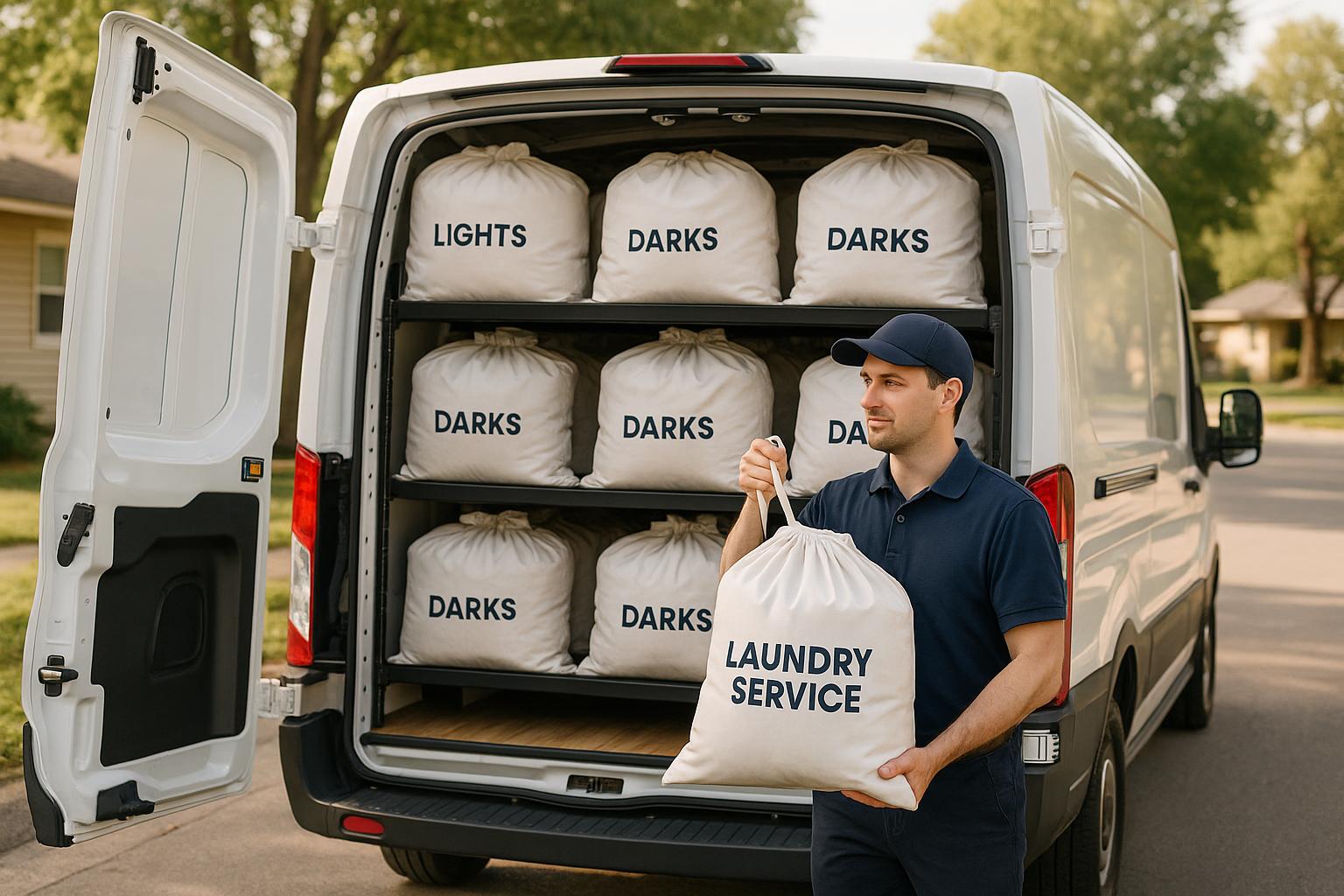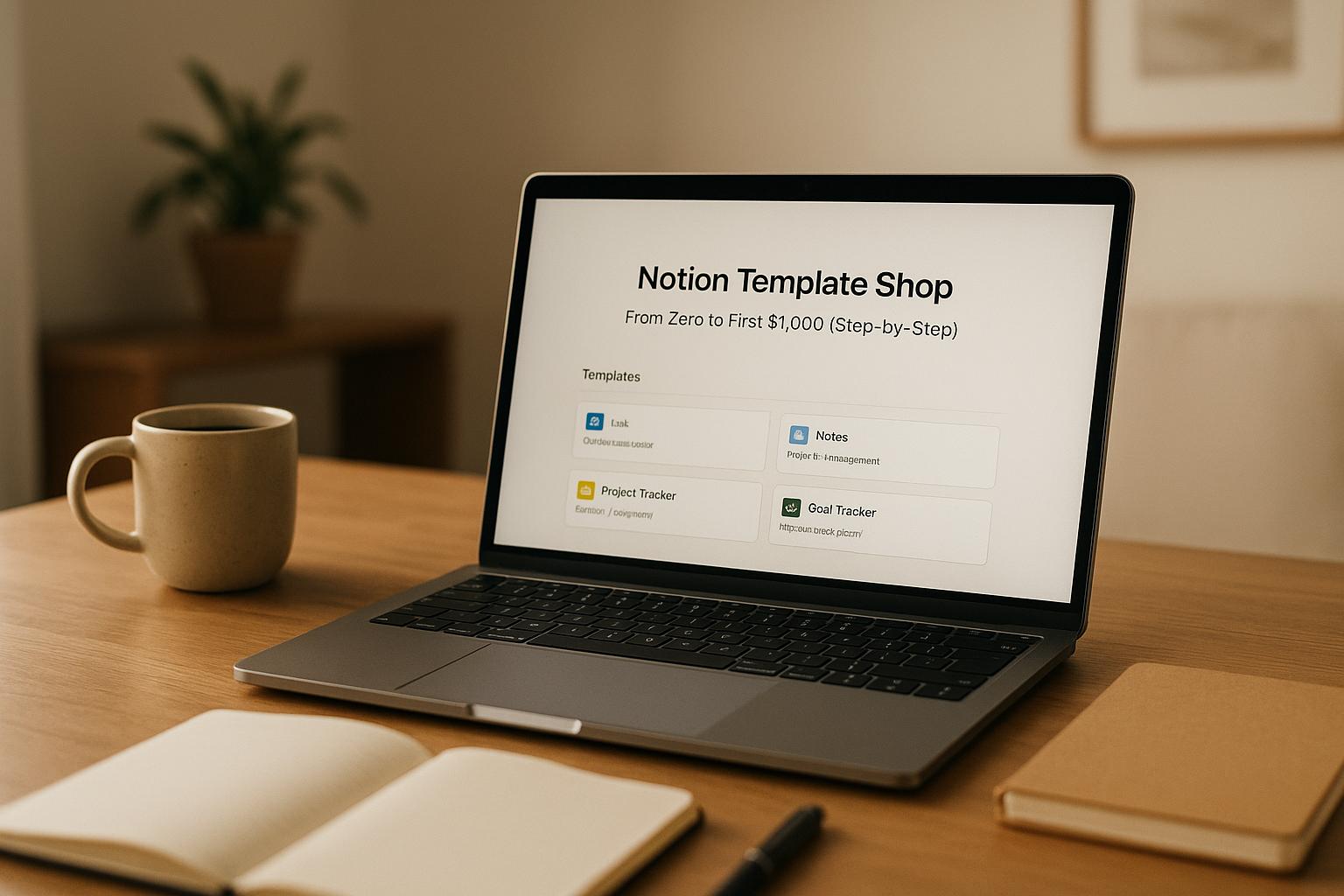
The laundry pickup and delivery business is growing fast, driven by busy lifestyles and urban living. Here’s what you need to know to start or improve your service:
- Laundry Bags: Choose durable, reusable options like canvas or waterproof vinyl for cost efficiency and customer satisfaction. Avoid single-use plastic for a more professional image.
- Route Planning: Define service zones using tools like geofencing to save time and fuel. Efficient routes improve delivery times and reduce costs.
- Profit Strategies: Understand startup costs (vehicles, insurance, equipment) and use pricing models like subscriptions or tiered pricing to boost revenue. Scaling smartly with tech tools can lower expenses and increase margins.
Focus on these areas to streamline operations, satisfy customers, and grow your business.
5 Figures a Month in 5 Months: Starting Laundry Pickup and Delivery!
Selecting Laundry Bags and Packaging
Choosing the right laundry bags isn’t just about convenience - it directly impacts how efficiently your operation runs and how satisfied your customers are. The right bags protect garments, make sorting easier for your team, and leave a polished impression on your clients. On the flip side, poor bag choices can lead to damaged items, frustrated customers, and higher operating costs. Focus on bags that are easy for drivers to handle, simplify sorting for staff, and look professional to customers.
Let’s break down the types of laundry bags available and how each one serves specific operational needs. Below, you’ll find an overview of common bag types and their best uses.
Laundry Bag Types and Applications
Mesh bags are great for handling delicate items and sorting tasks. Their breathable material prevents moisture buildup and allows for quick identification of contents. However, they’re not ideal for transporting dirty laundry from customers’ homes since they don’t contain odors or prevent items from spilling out during transit.
Canvas bags are built for durability and can handle heavy loads without tearing. They’re perfect for pickup and delivery routes where bags endure frequent use. These bags also offer a professional look and can be customized with your company’s logo. While the upfront cost is higher than disposable options, their longevity often makes them a worthwhile investment.
Waterproof vinyl bags are designed to handle wet or heavily soiled laundry. They prevent leaks that could damage other garments or the interior of your delivery vehicle. These bags are especially useful for items like damp athletic gear or work uniforms. Plus, their sealed design helps contain odors during transport.
Drawstring plastic bags are a budget-friendly, single-use option. They’re lightweight, inexpensive, and can be printed with your company’s branding. However, their disposable nature and limited sustainability may give off a less premium impression compared to reusable alternatives.
Laundry hamper bags with rigid frames are ideal for situations involving large volumes of laundry. These collapsible containers make loading and unloading easier for drivers while offering a high-end feel. They’re particularly suitable for commercial clients like salons, restaurants, or medical offices.
Cost, Durability, and Environmental Factors
When evaluating laundry bags, think beyond the initial purchase price. Consider factors like how often you’ll need to replace them, how much storage space they require, and the time spent managing them. A slightly more expensive bag that lasts longer can save you money in the long run.
| Bag Type | Cost Per Unit | Durability (Uses) | Environmental Impact | Best Application |
|---|---|---|---|---|
| Mesh Laundry | $2.50 - $4.00 | 50–100 uses | Low impact, recyclable | Delicate sorting, in-facility use |
| Canvas | $8.00 - $15.00 | 200–500 uses | Very low impact, biodegradable | Premium service, heavy loads |
| Waterproof Vinyl | $3.00 - $6.00 | 75–150 uses | Moderate impact, partly recyclable | Wet items, odor control |
| Drawstring Plastic | $0.15 - $0.30 | Single use | High impact, limited recycling | Budget service, disposable needs |
| Hamper Bags | $12.00 - $25.00 | 300–600 uses | Low impact, long-lasting | Commercial clients, high volume |
Durability is key. Test potential bag options under real-world conditions, paying close attention to stress points like handles, seams, and closures. A bag that fails after just a few uses can disrupt operations and increase replacement expenses.
Environmental responsibility is another factor to weigh. Many customers value eco-conscious practices, so opting for reusable bags made from sustainable materials - like canvas or natural fibers - can reflect positively on your business. On the other hand, single-use plastic bags may not align with these values.
Storage and handling also play a role in operational efficiency. Choose bags that fold flat or nest easily to save space in your facility and delivery vehicles. This can streamline loading and unloading, making your routes more efficient.
Lastly, consider how seasonal weather might affect your choice. In rainy climates, waterproof bags are a must to protect items during transport. In hot, humid conditions, breathable materials are better for preventing odors and moisture buildup. By tailoring your bag selection to both weather and customer needs, you’ll ensure consistent service quality year-round.
Route Planning and Delivery Optimization
Planning efficient routes is a key part of running a successful laundry pickup and delivery service. Just like choosing the right bags or maximizing profits, organizing routes effectively keeps operations running smoothly. A big part of this process involves setting clear service areas and customer zones, which helps streamline deliveries and keeps customers happy. Let’s dive into how to set up service areas that make your delivery process more efficient.
Setting Your Service Area and Customer Zones
Your service area should align with both your business capacity and your customers’ needs. By defining specific zones, you can avoid taking on routes that aren't worth the effort while keeping deliveries manageable and timely.
One way to achieve this is by using geofencing. This technology allows you to create virtual boundaries based on neighborhoods or zip codes. With geofencing in place, orders are assigned to specific areas, making operations smoother and ensuring customers get reliable service.
sbb-itb-08dd11e
Profit Maximization Strategies
Turning a small laundry service into a thriving business requires more than just clean clothes and timely deliveries. Smart financial management is the backbone of profitability. By understanding your costs, setting competitive prices, and scaling efficiently, you can create a sustainable and lucrative operation.
Startup and Operating Cost Breakdown
Starting a laundry service means carefully planning your budget across several key areas. One of the biggest upfront costs is transportation - whether you're buying or leasing delivery vehicles. On top of that, you'll need to account for insurance, equipment, and supplies. Labor costs and investments in technology, like point-of-sale systems and route optimization tools, are also critical for keeping operations smooth and efficient. Planning these expenses wisely is crucial to maintaining a steady cash flow.
Once your costs are clear, the next step is figuring out how to generate revenue effectively.
Revenue Models and Pricing Methods
A variety of pricing strategies can help meet different customer needs. For example:
- Flat-rate pricing keeps things simple for standard service loads.
- Subscription plans can lock in recurring revenue by offering regular services at a discounted rate.
- Tiered pricing based on turnaround times lets you charge more for urgent orders.
Want to stand out even more? Add premium services like stain treatments or special care for delicate fabrics. These extras not only bring in additional income but also set your business apart from competitors.
Scaling and Increasing Profit Margins
Once you've nailed your pricing strategy, it's time to scale. Growth doesn’t just mean more customers - it means smarter operations. Technology is your ally here. Tools like route optimization software, customer management platforms, and point-of-sale systems help cut down on manual work and reduce costs.
As your business grows, economies of scale kick in. Buying supplies in bulk and optimizing delivery routes can significantly lower your per-service costs. Expanding into nearby neighborhoods or densely populated areas can open new markets while keeping operations efficient. Thoughtful growth ensures that every new step supports your bottom line.
Conclusion: Building a Successful Laundry Service
Running a profitable laundry pickup and delivery service boils down to excelling in three key areas: choosing the right laundry bags, planning efficient routes, and maximizing profits strategically. These elements work together to streamline operations and fuel steady growth.
Selecting the right laundry bags isn’t just about practicality - it’s an opportunity to make a lasting impression. Branded packaging can elevate your business image, reinforcing professionalism and helping your service stand out.
Efficient route planning transforms what could be logistical chaos into a well-oiled machine. Using modern tools and understanding your local service area allows you to cut fuel costs and improve delivery times. This not only boosts customer satisfaction but also strengthens your financial foundation.
On top of that, sound cost management and flexible pricing models ensure your revenue streams remain strong and adaptable.
Success in the laundry service industry isn’t about excelling in just one area - it’s about bringing everything together. When your bags represent your brand, your routes operate smoothly, and your pricing supports sustainable growth, you create a business that’s both efficient and customer-centric. This balance is what drives consistent profits.
As demand for convenient laundry solutions continues to rise among busy families and professionals, focusing on these essentials - and delivering quality service - positions your business to thrive and capture new opportunities in a growing market.
FAQs
Why should I use reusable laundry bags instead of single-use plastic bags for my pickup and delivery service?
Reusable laundry bags bring a range of benefits compared to single-use plastic options. They’re long-lasting, save money over time, and help cut down on waste - an appealing choice for customers who care about the environment. Plus, their sturdy construction offers better protection for clothes during transport, which can lead to happier customers.
These bags also make day-to-day operations smoother. Many come with handy features like drawstrings or zip closures, making them easy to handle and organize. Over time, this can elevate your business's professionalism and strengthen customer loyalty.
How does geofencing technology help streamline delivery routes in a laundry service business?
Geofencing technology simplifies delivery operations by establishing virtual boundaries around specific service areas. These boundaries help businesses outline exact zones for pickups and deliveries, ensuring drivers stick to designated routes and avoid unplanned detours.
When combined with route optimization tools, geofencing can help map out the most efficient paths. This reduces travel time, cuts down on fuel expenses, and boosts overall operational efficiency. Plus, it helps keep customers happy by ensuring their pickups and deliveries are on time.
What are the best pricing strategies to boost profits and keep customers happy in a laundry pickup and delivery service?
To boost profits while keeping customers happy, try these pricing approaches:
- Per-pound pricing: Charge customers based on the weight of their laundry. This method is straightforward and gives them flexibility.
- Flat-rate pricing: Set fixed rates for specific services, like wash-and-fold. It simplifies choices and makes pricing clear.
- Subscription plans: Offer weekly or monthly packages at a discounted rate. This not only encourages repeat business but also builds customer loyalty.
- Tiered pricing: Introduce premium rates for faster turnarounds or specialized services, such as stain removal or handling delicate fabrics.
To make your pricing stand out, consider offering extras like eco-friendly detergents or contactless delivery options. At the same time, focus on streamlining your operations - optimizing delivery routes and cutting unnecessary costs can help you maintain strong profit margins while keeping customers satisfied.
Related Blog Posts
Get the newest tips and tricks of starting your business!


